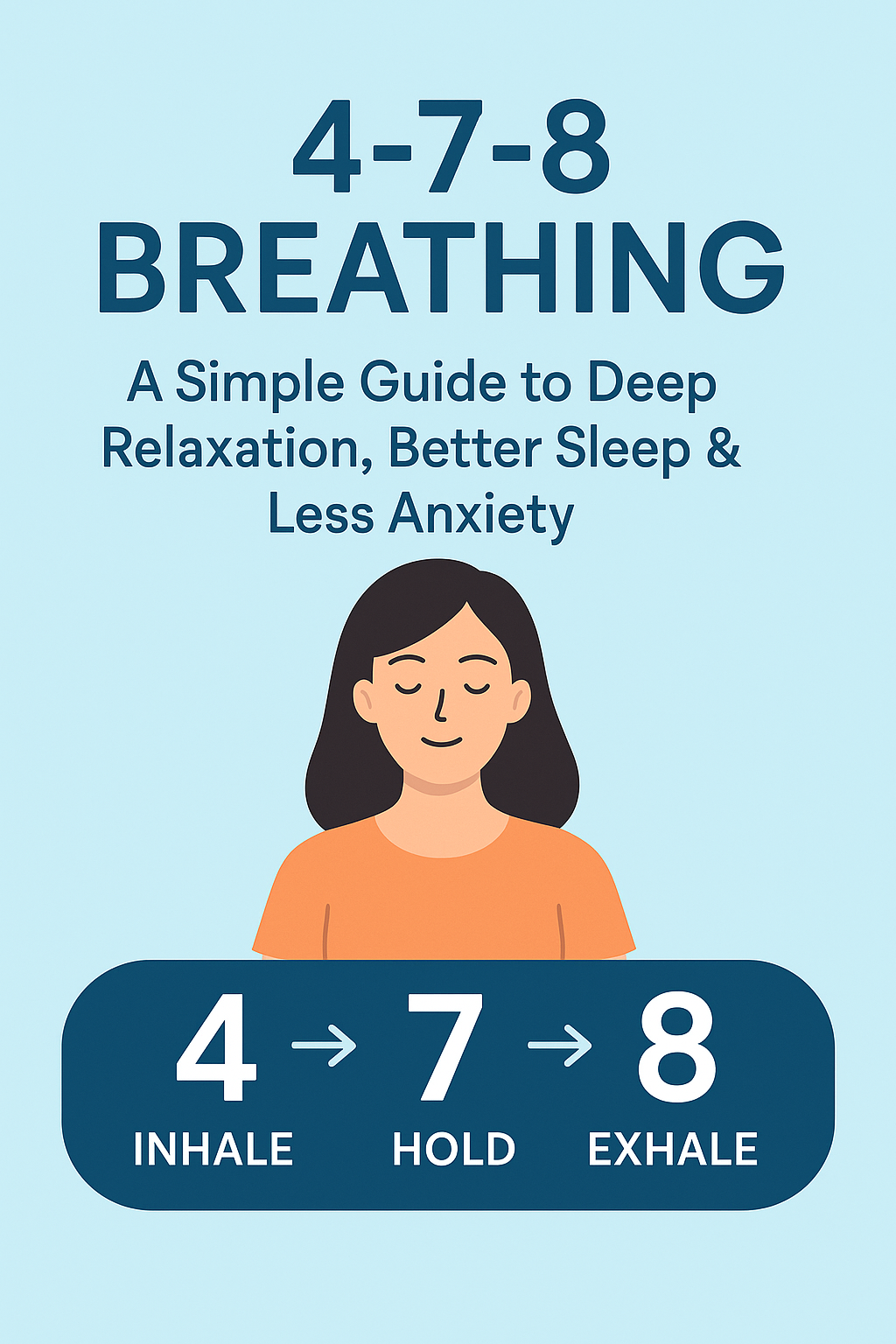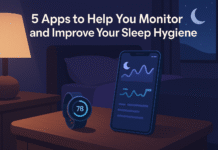Breathing is the one bodily process you can both ignore and control — and the “4-7-8” breathing method is a simple, portable pattern that harnesses that control to create fast, reliable calm. In this article you’ll learn what the 4-7-8 technique is, why it can lower anxiety and help you sleep, how to do it correctly, how to adapt it safely to your needs, and how to build it into a practical 4-week starter plan. This guide is written for busy adults, shift workers, students, and anyone who wants a no-equipment tool to manage stress and improve sleep.
Medical disclaimer: breathing techniques are generally safe for healthy adults, but this article is educational and not medical advice. If you have a respiratory condition (severe asthma, COPD), uncontrolled heart disease, recent surgery, or are pregnant, consult a qualified health professional before beginning any new breathing program.
Key takeaways
- What it is: The 4-7-8 method is a timed breathing pattern (inhale 4, hold 7, exhale 8) designed to activate relaxation quickly.
- Why it works: Slow, intentional breathing can increase parasympathetic activity, improve heart-rate variability (HRV), and reset stress responses — effects shown in multiple studies of paced breathing.
- How to do it: No equipment needed — sit or lie comfortably, keep counts steady, and exhale with a soft “whoosh.” Start slowly and respect your limits.
- Practice plan: Brief daily sessions (2–5 minutes, twice daily) build tolerance; a 4-week starter plan is included to make it habitual.
- Safety: Dizziness and lightheadedness are the most common early issues; reduce counts if needed and consult a clinician for serious health concerns.
What the 4-7-8 method is and its core benefits
What it is (plainly): The 4-7-8 breathing method is a structured breath pattern where you inhale for 4 counts, hold your breath for 7 counts, and exhale for 8 counts. It’s designed to be a quick tool for calming the nervous system and is intentionally simple so anyone can practice it anywhere.
Core benefits and purpose
- Rapid reduction in acute stress and anxiety. Practitioners report immediate subjective calm after even a single set. Clinical and research literature on paced breathing demonstrates that slow, deliberate breathwork can lower subjective anxiety levels and damp sympathetic arousal.
- Improved sleep onset. Many people use 4-7-8 at bedtime to quiet racing thoughts and fall asleep faster; controlled exhalation helps shift physiology toward rest.
- Better breath control and diaphragmatic engagement. The pattern reinforces slow, deeper diaphragmatic breathing, which improves breathing efficiency and reduces accessory muscle overuse.
- Possible effects on heart-rate variability and blood pressure. Slow paced breathing near a person’s resonance frequency has been associated with increased HRV and transient blood-pressure changes — markers linked with better stress resilience.
Requirements / prerequisites
- Equipment: None. Comfortable chair or bed is optional.
- Skills: No prior breathing training required.
- Cost: Free.
- Low-cost alternatives: Guided audio on a smartphone, a simple metronome app set to the chosen counts, or a watch with a vibration timer.
Mini sample (2–3 steps)
- Sit comfortably and relax your face and shoulders.
- Inhale gently through the nose for a slow count of 4; hold for 7; exhale with a gentle “whoosh” for 8. Repeat 3–4 times.
Beginner progression
- Start with one or two cycles. As you adapt, increase to 4–8 cycles per session, and add sessions (morning, pre-sleep, or during stress spikes).
Safety & common mistakes
- Mistake: Pushing counts so long you become dizzy. Fix: Shorten counts but keep the 4:7:8 ratio (for example, 3:5:6).
- Safety caveat: People with significant lung or cardiac disease should check with a clinician first.
How the method works — the physiology behind 4-7-8
What it is and purpose
This section explains the physiological mechanisms that give the 4-7-8 method its effect: controlled breathing influences the autonomic nervous system, blood-gas levels, and cardiovascular rhythms to create a shift from fight-or-flight toward rest-and-digest.
Key mechanisms (concise)
- Parasympathetic activation: Slow, prolonged exhalation tends to increase vagal (parasympathetic) activity, which reduces heart rate and promotes calm.
- Heart-rate variability (HRV) modulation: Slow breathing near resonant frequencies (~6 breaths/min or 0.1 Hz) amplifies the natural oscillations between heart rate and breathing, a phenomenon that correlates with improved self-regulation. While 4-7-8 does not precisely match 6 breaths per minute for every person, it taps the same principle of paced, slow respiration.
- CO₂ balance and chemoreception: Breath holds slightly raise CO₂ briefly, which can reduce the tendency to over-breathe and modulate the brain’s alarm centers; this controlled rise and gradual exhalation fosters steadier physiology.
Requirements / prerequisites
- No monitoring of heart rate or oxygen is required for healthy users.
- For research-grade HRV measurements you’d need a chest strap or validated wearable if you want objective metrics.
Step-by-step implementation (science-friendly version)
- Adopt a neutral, upright posture to allow diaphragmatic motion.
- Breathe through the nose for the inhale (4 counts) to promote nasal airflow benefits.
- Hold the breath for 7 counts — this increases tidal hold time and may modestly elevate CO₂.
- Exhale fully through the mouth for 8 counts, encouraging longer exhalation and vagal activation.
Beginner modifications & progressions
- Modify counts: Keep the ratio but shorten counts (e.g., 3:5:6) if holding for 7 is uncomfortable.
- Progression: Gradually return to the 4:7:8 ratio and expand the number of cycles per session to increase training effect.
Recommended frequency/duration/metrics
- Beginner: 1–2 sets per session (each set = 4 cycles), twice daily.
- Intermediate: 2–3 sessions/day or 3–4 sets per session as tolerance builds.
- Metrics: subjective anxiety ratings, sleep latency (minutes to fall asleep), or HRV measures (RMSSD or SDNN) if you use a wearable. Clinical evidence suggests multi-session practice over weeks yields measurable benefits.
Safety, caveats, mistakes
- Dizziness from rapid changes in breathing is most common; stop and breathe normally if it happens.
- Avoid prolonged breath holding beyond comfortable tolerances.
- Contraindications: recent ear or sinus surgery, severe COPD, or unstable cardiac conditions — consult a clinician.
Mini plan (2–3 steps)
- Test one comfortable 4-cycle set in the morning.
- Repeat one set before bed; note sleep onset time. Increase to two sets as tolerated over the next week.
Requirements, tools, and low-cost alternatives
What it is and its purpose
This section is purely practical: what you need (spoiler: very little) and how to get the most out of the method without spending money.
Requirements
- Physical: A quiet, comfortable place to sit or lie where you won’t be interrupted for a few minutes.
- Time: 2–10 minutes per session depending on your plan.
- Mental: A willingness to practice regularly and tolerate brief awkwardness as your breathing retrains.
Tools (optional)
- Timer/metronome: A simple interval timer or metronome app can cue inhalation, hold, and exhalation counts.
- Wearable (optional): A heart-rate monitor or wearable that reports HRV if you want objective feedback.
Low-cost alternatives
- Use the timer on your phone, or silently count with the breath ratio.
- Use a free guided audio track or short video that leads you through the counts.
- If breath holding is difficult, practice “4:4:6” or “3:5:6” ratios first until comfortable.
Step-by-step (setup)
- Find a quiet 2–5 minute window.
- Sit with feet on the floor and hands relaxed, or lie on your back with one hand on your belly to feel the diaphragm.
- Start the pattern at a tempo that feels comfortable; use a timer only if it helps.
Beginner modifications
- Seated vs. supine: Many beginners find lying down safer and more comfortable initially.
- Shorter holds: Temporarily change the hold to 4 or 5 seconds rather than 7 until breath control improves.
Frequency/duration
- Start with daily practice (morning and bedtime recommended) and gradually increase to multiple sessions per day for stress resilience.
Safety & mistakes
- Using a rapid metronome with loud beeps can provoke anxiety — prefer gentle cues.
- Don’t strain to meet counts; the ratio matters more than absolute seconds.
Mini-plan (2–3 steps)
- Day 1–3: 2 sessions/day, 1 set of 3 cycles.
- Day 4–7: 2 sessions/day, 1 set of 4 cycles. Increase gradually thereafter.
Clear step-by-step instructions (detailed how-to)
What it is and core purpose
Here’s a full, user-friendly walkthrough of exactly how to do the 4-7-8 method so you can practice right now.
Before you begin
- Sit upright or lie down. Relax jaw and shoulders. Place the tip of your tongue against the ridge behind the upper front teeth and keep it there throughout (this is optional but can help regulate airflow and sound).
Step-by-step (full sequence)
- Exhale completely through your mouth, making a soft whoosh sound. (This primes the lungs.)
- Close your mouth and inhale quietly through your nose for a slow count of 4. Count steadily with a mental cadence.
- Hold your breath for 7 counts. Keep your body relaxed and avoid tensing.
- Exhale completely through your mouth, making a whoosh sound, for a count of 8. Try to empty the lungs without forcing.
- Repeat the cycle for 4 full breaths initially. Build up to 8 cycles as comfortable.
Tips for counting
- Count in seconds roughly, but don’t obsess about millisecond accuracy — smoothness matters more than strict timing.
- Use an internal “one-two-three-four” cadence or a gentle app reminder until counts feel natural.
Beginner modifications & progressions
- If holding for 7 is hard: shift to 3:4:5 or 3:5:6 then slowly work back to the 4:7:8 ratio.
- If you get lightheaded: return to normal breathing for a minute and reduce counts next time.
- Progression: once comfortable with 4 cycles, add cycles or increase session frequency to deepen training effects.
Recommended frequency/duration
- Trial: 1 set of 4 cycles twice daily for one week.
- Maintenance: 2–4 sets/day or use on demand during stress spikes. Sessions as short as 2–5 minutes can be effective; longer sessions increase cumulative benefit.
Safety, caveats & common mistakes
- Common mistake: forcing breath or tensing shoulders. Keep breaths smooth and diaphragmatic.
- Caveat: People with panic disorder sometimes find breath control triggers panic; work slowly and consult a clinician if panic worsens.
Mini-practice (2–3 steps)
- Exhale fully; inhale 4; hold 7; exhale 8.
- Repeat 4 cycles, rest, and notice any change in heart rate or mental state.
Beginner modifications and progressions (how to scale or simplify)
What it is and purpose
This section gives practical pathways for people who need gentler entry points or want to scale practice for greater benefit.
Simplify (if you’re new or have respiratory limits)
- Shorten the ratio while preserving proportions: 3:5:6 or 2:3:4. Keep the exhale longer than the inhale.
- Reduce cycle count: do 1–2 cycles per session at first.
- Use diaphragmatic cueing: place a hand on your belly and make sure it rises on inhale.
Progressions (how to advance)
- Increase cycles: from 4 → 6 → 8 cycles per session over several weeks.
- Add sessions: from 2/day → 3/day (morning, midday, pre-sleep).
- Combine: pair with short progressive muscle relaxation or a guided body scan after 4–7–8 to deepen relaxation.
Recommended frequency/duration
- Gentle start: daily or every-other-day practice, 2–5 minutes/session.
- Moderate training: daily sessions, 5–15 minutes total across multiple brief sets. Research suggests repeated, guided, and multi-session practice tends to produce better outcomes than single, brief exposures.
Safety & mistakes
- Avoid increasing intensity too fast; fatigue and breathlessness are signs to back off.
Mini-plan (2–3 steps)
- Week 1: 3:5:6 ratio, 1 set of 2 cycles in morning and evening.
- Week 2: Move to 4:7:8 for 1 set, increase to 4 cycles; add a midday session.
Recommended frequency, duration, and how to measure progress
What it is and core purpose
This section explains a practical schedule for practice and ways to measure whether the technique is helping you.
Practice frequency & duration recommendations
- Daily micro-practice: 2–5 minutes, morning and before bed.
- On-demand use: any time you feel anxious, before presentations, or while waiting in lines.
- Training goal: aim for consistency (daily or near-daily) rather than long isolated sessions — repeated short practice builds conditioning. Evidence from breathwork research supports multi-session programs for stress reduction.
How to measure progress (subjective and objective)
- Subjective measures (easy):
- Track sleep latency (minutes to fall asleep) in a simple sleep log.
- Rate nightly sleep quality on a 1–5 scale.
- Use a short anxiety rating (0–10) before and after sessions.
- Objective measures (optional):
- Resting heart rate and changes over weeks.
- Heart-rate variability (HRV) via a validated wearable (track RMSSD or nightly HRV trends). Improvements in HRV can indicate better autonomic balance over time.
Recommended KPIs
- Fall asleep 10–20 minutes faster than baseline (if insomnia is the target).
- 1–3 point reduction on a 0–10 subjective anxiety scale after a 2–4 week training period.
- A small but steady upward trend in resting HRV over several weeks if measured reliably.
Safety & caveats
- Don’t use HRV short-term changes as the only marker; HRV fluctuates with many factors (sleep, hydration, illness). Use it as one piece of feedback.
Mini-plan (2–3 steps)
- Start a simple log: record sessions, pre/post anxiety rating, and sleep latency.
- Evaluate weekly for changes and adjust session frequency accordingly.
Safety, caveats, and common mistakes to avoid
What it is and core purpose
Breathe safe. This section highlights who should take extra care and common pitfalls so you can practice the technique without problems.
Safety concerns
- Lightheadedness/dizziness: most common early issue. Pause and breathe normally. Reduce counts if dizziness persists.
- Respiratory disease: people with serious lung conditions (severe asthma, advanced COPD) should consult their provider.
- Cardiac concerns: anyone with unstable cardiac symptoms should check with their clinician before starting breath-holding practices.
- Pregnancy & surgery: discuss with your clinician if you have recent abdominal surgery or are pregnant and find breath holds uncomfortable.
Common mistakes
- Forcing the breath: don’t strain; smooth, relaxed breathing is the goal.
- Tension in shoulders or jaw: keep the upper body relaxed.
- Using the method as the only therapy for severe anxiety or insomnia: breathwork helps many people but is not a replacement for evidence-based medical or psychological care when conditions are moderate to severe.
Practical safety tips
- Practice seated initially so you can stop quickly if dizzy.
- Keep practice short and gradual during the first week.
- If breath holding provokes panic or intense discomfort, switch to gentler breathing methods and consult a mental-health professional.
Mini-plan (2–3 steps)
- Start seated with low counts if you have health concerns.
- Track any adverse effects and stop training if symptoms persist; seek medical advice.
Practical add-ons: quick-start checklist, warm-up, troubleshooting, and a 4-week starter plan
Quick-start checklist
- Find a comfortable chair or bed.
- Block 5 quiet minutes.
- Remove tight clothing around the neck and chest.
- Sit with a neutral spine or lie down.
- Decide counts (start with 4:7:8 or a shortened ratio).
- Keep a notepad or phone to track results.
Simple warm-up (60–90 seconds)
- Take 3 gentle diaphragmatic breaths (inhale to belly, exhale slowly).
- Roll shoulders and unclench jaw.
- Begin the 4-7-8 sequence.
Troubleshooting / common pitfalls
- I feel panicky when holding my breath. Shorten the hold (3–4 seconds) and focus on gentle exhalation. Consider combining with grounding techniques (5–4–3–2–1 sensory check).
- I get lightheaded. Stop, breathe naturally for a minute, and reduce counts. Practice shorter holds until you adapt.
- I don’t notice any effect. Increase practice frequency for 2–4 weeks — repeated exposure often yields cumulative benefit. Combine breathwork with other sleep hygiene measures if your goal is improved sleep.
How to measure progress (quick)
- Keep a 1-line daily log: sessions completed / sleep latency / anxiety score.
- Optionally, use a wearable to monitor resting heart rate and nightly HRV trends.
4-week starter plan (simple roadmap)
Week 1 — Orientation
- Frequency: morning and night.
- Pattern: start with 3:5:6 for 2 cycles per session.
- Goal: build comfort with breath holds and diaphragm movement.
Week 2 — Consolidation
- Frequency: morning, midday (optional), night.
- Pattern: try 4:7:8 for 1 set of 4 cycles in the evening; use shortened ratio in morning if still uncomfortable.
- Goal: make practice consistent and notice any sleep changes.
Week 3 — Expansion
- Frequency: morning, afternoon (stress points), night.
- Pattern: 4:7:8 for 2 sets (4 cycles each) at night; 1 set in the morning.
- Goal: use on-demand for acute stress and track sleep latency.
Week 4 — Personalization
- Frequency: 2–3 sessions/day as needed.
- Pattern: 4:7:8 for 2–3 sets per session; combine with a 2–5 minute body scan before bed.
- Goal: evaluate outcomes (sleep, anxiety) and choose a maintenance schedule.
Mini example daily routine (2–3 steps)
- Morning: 1 set (4 cycles) to start the day calm.
- Pre-sleep: 2 sets (4 cycles each) to unwind and cue sleep.
How to measure results and decide if it’s working
What it is and purpose
Simple metrics help you decide whether to keep, adapt, or pause the practice.
Simple subjective measures
- Sleep latency: record how many minutes it takes to fall asleep.
- Pre/post anxiety score: 0–10 scale, before and after a session.
- Feeling scale: morning note—better / same / worse.
Objective measures (optional and more advanced)
- Resting heart rate trends over weeks.
- HRV using validated devices — look for gradual improvements rather than day-to-day noise. Research suggests resonance breathing and other paced breathing techniques can alter HRV patterns, but individual responses vary. FrontiersPMC
When to adapt or stop
- If sleep or anxiety worsens after a week of consistent practice, reduce counts and consult a professional.
- If sessions consistently cause dizziness or chest discomfort, stop and seek medical advice.
Mini-plan (2–3 steps)
- Keep a 7-day baseline log before starting (sleep latency, anxiety) if possible.
- Compare week 4 values to baseline to evaluate whether to continue or change the approach.
Frequently Asked Questions (FAQs)
1. How long before I feel the effects?
Many people notice a calming effect within one cycle, but consistent benefits (for sleep and baseline anxiety) usually emerge after days to weeks of regular practice.
2. Can I do 4-7-8 while lying down?
Yes. Lying down is often more comfortable for beginners. Ensure you can easily stop if you feel dizzy.
3. Is 4-7-8 the same as pranayama or other yogic breathing?
It borrows from traditional pranayama principles (timed breathing and extended exhalation) but is presented as a simple, secular pattern for stress relief.
4. Will it help with panic attacks?
Some people find it helpful; others may find breath control triggers panic. Start slowly, and seek professional guidance if you have panic disorder.
5. How is this different from slow-paced breathing at 6 breaths/minute?
4-7-8 is a ratio-based exercise; while it aims for slower breathing, individual resonance frequency varies. Resonance breathing research often centers on ~6 breaths/min; 4-7-8 taps similar physiology but is not personalized to an individual’s exact resonance frequency. PMCNature
6. Can I use 4-7-8 during exercise?
No. Use it at rest. During exercise you need different breathing patterns to meet metabolic demands.
7. Are there any long-term downsides?
For healthy users, long-term practice is low risk. The main issues are mild lightheadedness or discomfort if counts are forced. Serious downsides are rare when practiced sensibly. PMC
8. Can children use it?
Older children and teens can use simplified ratios under supervision; for younger children consult a pediatric clinician. Keep counts short and comfortable.
9. Should I breathe through my nose or mouth?
Inhale through the nose (if comfortable) and exhale through the mouth with a soft whoosh; nasal inhalation supports filtration and mild nitric oxide benefits, though exhalation through the mouth is part of the technique.
10. How does 4-7-8 compare with other breathwork for anxiety?
Research on breathwork shows many structured breathing practices can reduce anxiety; benefits often come from regular, guided practice rather than any single “best” technique. Use what you can practice consistently. Frontiers
Conclusion
The 4-7-8 breathing method is a low-cost, low-risk tool for immediate relaxation and long-term stress resilience when practiced consistently. It requires no equipment, takes only minutes, and can be adapted to most fitness and health levels. Start gently, use the 4-week starter plan to build habit, and measure simple outcomes like sleep latency or an anxiety rating to see if it’s helping. If you have medical concerns, consult a qualified professional before beginning.
Call to action: Try one full 4-cycle 4-7-8 session now and write down how you feel — small experiments start meaningful change.
References
- Breathing Exercises: Three To Try | 4-7-8 Breath — DrWeil.com. Published online. https://www.drweil.com/health-wellness/body-mind-spirit/stress-anxiety/three-breathing-exercises-and-techniques/
- How To Do the 4-7-8 Breathing Exercise — Cleveland Clinic. Published March 2022. https://health.clevelandclinic.org/4-7-8-breathing
- What to Know About 4-7-8 Breathing — WebMD. Published 2023. https://www.webmd.com/balance/what-to-know-4-7-8-breathing
- The Impact of Resonance Frequency Breathing on Measures of Heart Rate Variability, Blood Pressure, and Mood — Frontiers in Public Health. Published 2017. https://www.frontiersin.org/articles/10.3389/fpubh.2017.00222/full
- Effect of Various Lengths of Respiration on Heart Rate Variability — PMC (open access). Published 2023. https://www.ncbi.nlm.nih.gov/pmc/articles/PMC10775838/
- Effectiveness of deep breathing exercises on anxiety, depression and sleep disorders after CABG — PMC (open access). Published 2025. https://www.ncbi.nlm.nih.gov/pmc/articles/PMC12287402/
- Effect of breathwork on stress and mental health: A meta-analysis of RCTs — Scientific Reports. Published 2022. https://www.nature.com/articles/s41598-022-27247-y
- Singing at 0.1 Hz as a Resonance Frequency Intervention to Improve HRV — PMC (open access). Published 2022. https://www.ncbi.nlm.nih.gov/pmc/articles/PMC9091602/
- 4-7-8 Breath (Patient handout, PDF) — Rutgers School of Nursing (Dr. Weil handout). Published 2020. https://nursing.rutgers.edu/wp-content/uploads/2020/07/Dr.-Weil-4-7-8-Breathing-Exercise.pdf
- Breathing Practices for Stress and Anxiety Reduction: A Systematic Review — PMC (open access). Published 2024. https://www.ncbi.nlm.nih.gov/pmc/articles/PMC10741869/
- Just Breathe: Using Breathwork for Wellbeing — The University of Arizona Magazine (overview article on breathwork). Published 2024. https://awcim.arizona.edu/health_hub/awcimagazine/just_breathe_using_breathwork_for_wellbeing.html




































